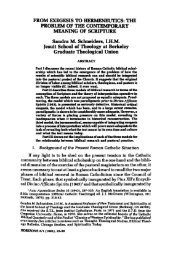WIFE AND SISTER THROUGH THE AGES - Blessed Edmund Rice ...
WIFE AND SISTER THROUGH THE AGES - Blessed Edmund Rice ...
WIFE AND SISTER THROUGH THE AGES - Blessed Edmund Rice ...
Create successful ePaper yourself
Turn your PDF publications into a flip-book with our unique Google optimized e-Paper software.
124 SEMEIAgorical interpretations of particular texts and the allegorical conventionitself finally drew their validity from the power of the interpretation tosupport the life of faith.CONCLUSIONThis essay began as an effort to comprehend both the stability andvariation evident in the history of interpretation of the Bible. Frequentlythe issue of stability and variation is discussed as a two term equation.The text represents the principle of stability and the individual interpreterrepresents the variable principle. Often the two principles are seen aslocked in a struggle over who will get to decide on the meaning of thepassage, the text itself or its interpreter. It will take no one by surprise thatI do not share the two term model. It is not clear to me that we know whatwe mean by "the text" or, if we do, that we can reach agreement on whatis determinative about it. Again, interpretation may involve a struggle, toquote again the Cheshire cat, over "who shall decide/' but it does not invariablyinvolve such a struggle. Nor does the text seem to me that stablenor the interpreter quite so variable. Often I would reverse the equation.And, obviously, add another term to it: interpretive conventions.I have not defined conventions, preferring to this point to allow themto emerge from the examination of specific instances of interpretation. Byconventions, however, I have understood structured sets of tacit rules andprocedures which govern the process of interpretation of texts. Conventionsare shared by communities of interpreters and are learned by participationin institutions in which textual interpretation is an integral part ofthe practice of the institution. As the interpretation has indicated, differentdistinguishable sets of conventions may exist within an institution orcommunity simultaneously, serving different purposes or responding todifferent circumstances.Conventions aid in addressing questions of stability and variation ininterpretation. First, conventions can help us understand why a presumablydeterminate text does not guarantee a single determinate interpretation.A text is multifaceted, composed of many potentially meaningfulelements, from unspoken gaps to the etymology of personal names andeverything in between.4 All of these elements are "in" the text and poten-4 Jonathan Culler described the multiplication of potentially meaningful elementsin the text inherent in structuralism's powerful descriptive Organon and offeredinterpretive conventions as a means of explaining which elements actually aremeaningful and which are not (Culler: 113-160). My use of conventions draws heavilyon his argument, but my reading of the history of interpretation indicates that interpretiveconventions organize features of the text in excess of those described throughstructuralist analysis.



